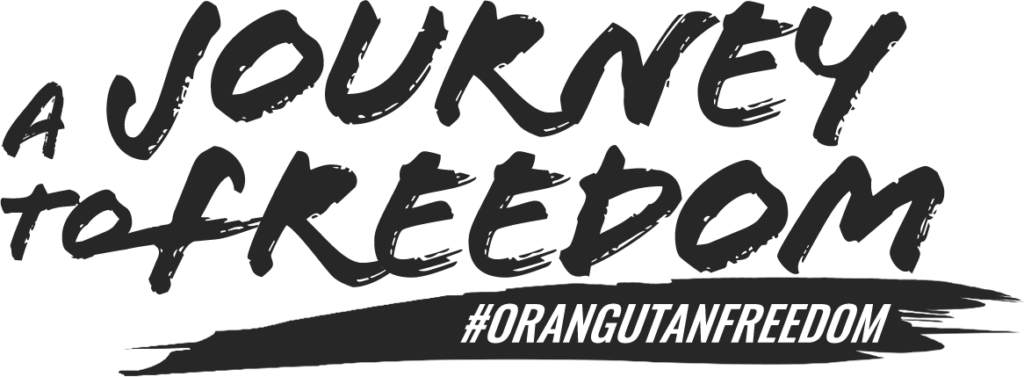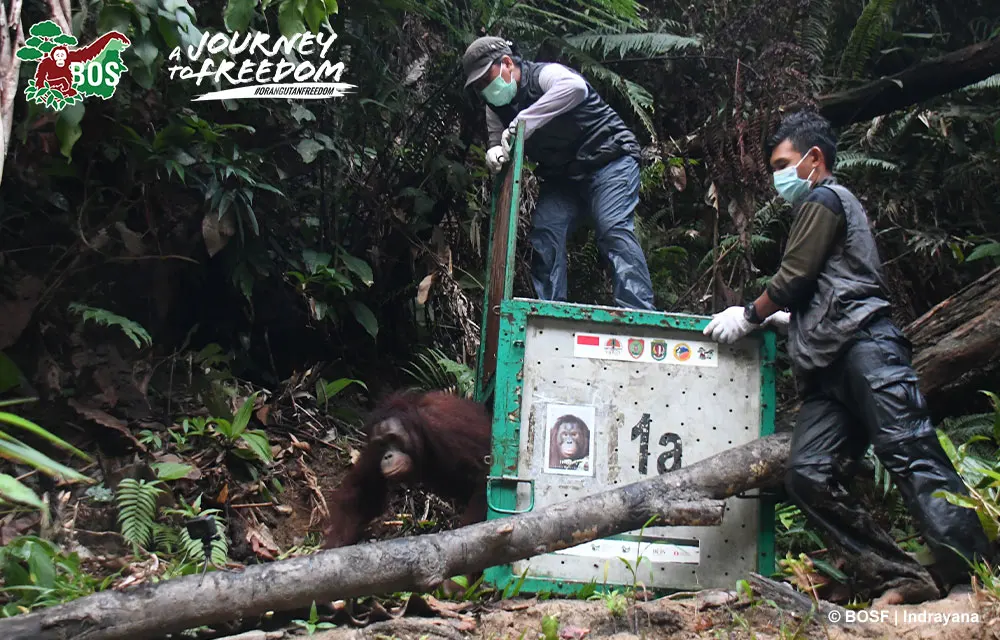Sebangau
Sebangau was rescued from Sebangau Kuala village, Pulang Pisau Regency, Central Kalimantan, on 18 October 2015. She was four years old at the time of her rescue and weighed 9.5 kilograms.
After the required quarantine period, Sebangau entered Forest School with other orangutans her age. On 5 February 2020, easy-going Sebangau, who loves to explore, continued on to the pre-release stage of rehabilitation on Badak Besar Island.
Sebangau is now 11 years old and weighs 34.7 kilograms. After undergoing a 7-year rehabilitation process at Nyaru Menteng, she is now ready to enjoy her freedom as a true, wild orangutan in the forests of the Bukit Baka Bukit Raya National Park.
Jazzboy
Jazzboy was rescued through a joint effort between the Central Kalimantan BKSDA wildlife rescue team and the BOS Foundation from Sampit, East Kotawaringin Regency, Central Kalimantan. He arrived at the Nyaru Menteng Orangutan Rehabilitation Centre on 14 April 2010, when he was 4.5 years old and weighed 13 kilograms.
After completing the quarantine period, Jazzboy joined Forest School for several years. On 5 February 2020, Jazzboy entered the pre-release stage of rehabilitation on Badak Besar Island. Thanks to his sound survival and exploratory skills, it wasn’t long before he made it onto the release candidate list to return to the forest.
Jazzboy is now 17 years old and weighs 34.2 kilograms. After 12 years of rehabilitation at Nyaru Menteng, Jazzboy is now ready to embark on a new adventure in the forests of the Bukit Baka Bukit Raya National Park (TNBBBR) in Central Kalimantan.
Itang
Itang was rescued from Kuala Kurun, Gunung Mas Regency, Central Kalimantan, on 14 June 2012. At the time of her rescue, she was only 18 months old, weighed five kilograms, and was allegedly found alone without a mother.
After a period of quarantine, Itang attended Forest School to hone her skills and abilities. She passed all stages of Forest School and continued to the pre-release stage of rehabilitation on Badak Besar Island on 5 February 2020. While not an aggressive orangutan, Itang is able to defend herself when needed. She adapts well to new environments and is good at responding effectively to new situations.
Itang is now 12 years old and weighs 32.1 kilograms. After undergoing a 10-year rehabilitation process, Itang has proven that she is more than ready to explore the forests of the Bukit Baka Bukit Raya National Park with her fellow release candidates.
Dius
Dius was handed over by a resident of Parenggean, East Kotawaringin Regency, Central Kalimantan, after being cared for by local residents. He arrived at the Nyaru Menteng Orangutan Rehabilitation Centre on 19 September 2006, when he was 18 months old and weighed 2.3 kilograms.
After being quarantined, Dius started his rehabilitation process in Forest School. After a few years, he had successfully completed all levels and was transferred to Badak Besar Pre-Release Island on 17 December 2019. He has since mastered all the skills needed to survive in the wild, and has started to grow cheek pads that frame his handsome face.
Dius is now 18 years old and weighs 33.4 kilograms. After undergoing a 15-year rehabilitation process, Dius is now ready to live wild and free in the Bukit Baka Bukit Raya National Park.
25th May 2022
An Adrenaline-Filled 39th Orangutan Release
![]()
![]()
![]()
Number of Orangutans
Release type
Wild Release
Release site
Bukit Baka Bukit Raya National Park

Release Candidates
Select an orangutan to view their bio
Dius
Itang
Jazzboy
Sebangau
There are certain moments you never forget, moments that hold special meaning and evoke strong emotions. I had such an experience during the 39th orangutan release conducted by the BOS Foundation in Central Kalimantan on May 18, 2022. As a member of the BOS Foundation’s communications team, this was a personal and meaningful experience for me.
Our latest orangutan release was made possible through a collaborative effort between the BOS Foundation, the Central Kalimantan Natural Resources Conservation Agency (BKSDA), and the Bukit Baka Bukit Raya National Park (TNBBBR) Agency. The operation involved the release of four orangutans into TNBBBR.
What got me so emotional was the fact that I had been part of the rehabilitation process for all four of these orangutans. I had closely followed their progress over the years, especially that of Dius. When he was less than two years old, Dius arrived at the Nyaru Menteng Orangutan Rehabilitation Centre as an orphan. Since I joined the BOSF team, I have documented his progress as I was tasked with telling his story for the individual donors who supported his rehabilitation process.
Before being released to the wild, all four orangutans lived semi-independently on pre-release islands. It was there, at the end of January, that the release process began when the four orangutans had to be collected from the pre-release islands. Catching Dius on Badak Kecil Island in particular was especially eventful. When we tried to approach Dius, his head was surrounded by bees! It appeared that he had just found and enjoyed some forest honey, and the angry bees were trying to attack him and anything that came near. Administering the anaesthesia was extremely difficult, as our technicians had to venture deep into the island and even had to swim to reach him.
Following several months in quarantine, to ensure they did not carry any diseases with them into the forest, the orangutans were finally ready for their true release. Dius and Jazzboy were the first to be anaesthetised, followed by Itang and Sebangau. All four orangutans were then transferred into transport cages. The team departed from Nyaru Menteng at 6 p.m. and arrived at Tumbang Hiran village, in Marikit sub-district, at around 2 a.m.
The next morning, our team continued the trip through the Hiran Watershed by kelotok, or boat. This leg of the journey proved to be quite difficult, due to wet weather conditions and receding river waters. Our team was put to the test, to the very end! Some sections of the river were quite tough to navigate and took a long time to pass. The wet weather made it even harder on our team, with continuous rainfall for more than an hour hampering the team’s efforts. We continued our journey until we arrived at Camp Hiran around 4 p.m. The team rested for less than half an hour, then continued on for about an hour to a release point upriver from camp.
Photo: Our team of technicians and the boat skipper work together to push the boat
Surprising everybody, instead of a climbing a tree, nosy Jazzboy turned around immediately after his release.
When the team arrived at the release point, it was Sebangau’s cage that was opened first. She immediately exited the cage and climbed up a tall tree to relax on its branches.
Handsome Dius was the next to be released; he rushed straight up the same tree as Sebangau. Dius was very interested in Sebangau and the two were seen copulating. They then explored the surrounding area and ate rattan piths together. Dius constructed a nest in a forest rambutan tree, ate some of its fruit, and rested near Sebangau.
At another location in the forest, our team opened the cage for Itang, who immediately climbed up a tree. She came down a short time later, but then climbed back up again to make a nest.
Surprising everybody, instead of a climbing a tree, nosy Jazzboy turned around immediately after his release. It seemed that Jazzboy was annoyed at being stuck in the cage for so long, so he quickly upended the cage and banged on a big log, before finally wandering off to explore his new forest home.
Photo: The PRM team during observations
We had completed the release process by sunset and headed back to Camp Hiran. The return journey was much more challenging, as the day was turning dark and visibility was limited. The rapids we had previously passed were now even more dangerous, with an increased risk of the boat capsizing.
The trip back to the camp had me very worried. The boat became stuck in the middle of a rapid when it became lodged between large rocks and I prepared myself for the worst. The technicians and I tried to help by pushing the boat. The skipper controlling the boat had to rely completely on our team members who knew the river conditions well enough to guide us back to camp. Luckily, after carefully navigating many more dangerous rapids, we were able to return to the camp at night.
This trip had me riding an emotional roller-coaster throughout as one moment I would experience overwhelming happiness and, the next, nail-biting anxiety and apprehension. My fear of the boat sinking and the feeling of panic when it got stuck between the big rocks in the middle of the river really got my adrenaline pumping!
However, it was worth every challenge we faced in order to give these four orangutans the opportunity to thrive and breed in the forest.
Text by: Andri Kornelius, Communications Team at Nyaru Menteng, Central Kalimantan
I also hope this inspire more people to care about orangutans and the environment and take action in their daily lives. It is on us all to help save orangutans!














